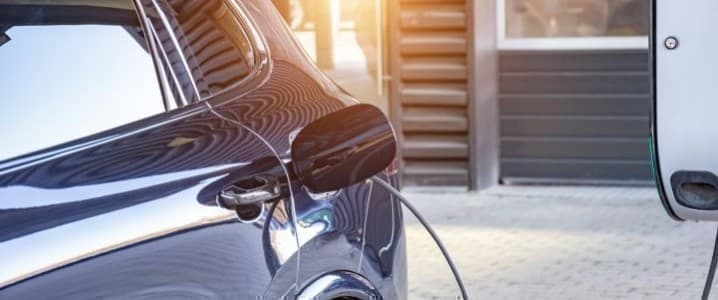Last month, large swathes of the United States grappled with sub-zero wind chills whereby freezing air from the Arctic set record-low temperatures leaving scores of people dead, created record-breaking energy demand and knocked out electricity to tens of thousands in the north-west. The frigid weather had another unintended consequence: it exposed just how vulnerable electric vehicles are to low temperatures with many EV drivers being left stranded after their vehicles prematurely run out of juice.
According to the American Automobile Association (AAA), an EV can lose as much as 12% of its range when temperatures drop to 20 degrees, and as much as 41% if you turn on the cabin heater. In other words, for every 100 miles of combined urban/highway driving at 20°F temperatures, the range of an EV drops to 59 miles. Range loss due to low temperatures varies according to the EV model, with a BMW 13s averaging 20.4% reduction in range at 21 F in combined HVAC on/off scenarios; Tesla Model S 75D loses 11.3% while a Volkswagen 3-golf sees a 6.9% deterioration. EV batteries work less efficiently in cold conditions while charging times can double or even triple for older EVs.
Luckily, a handy solution could be around the corner: Researchers from the University of Birmingham are working on an energy storage system that combines microwave energy and a chemical heat pump to produce heating or cooling on demand.
Dubbed e-Thermal bank, the system is designed as a secondary energy source for EVs that can harness electricity to drive a high-density (1600Wh/Kg) thermochemical-based system. The thermal bank is ‘charged’ at the EV charging station by using microwave energy to dissociate a solid-vapor working pair. Related: WTI Pops as Red Sea Shipping Echoes in Slumping European Diesel Supply
During discharging, the process is reversed by feeding the vapor into a reactor to generate heat, while the opposite phase uses an evaporator to generate cooling simultaneously. In effect, this charging process stores microwave energy inside the car, in the e-Thermal bank.
“We aimed to offload these thermal management tasks to a microwave driven process. Microwave is a fast heating method, because microwaves penetrate uniformly through materials and so deliver energy evenly into the body of the material,” Professor Yongliang Li, who is chair in Thermal Energy Engineering in Birmingham’s School of Chemical Engineering, said, as reported by Coolingpost.com.
The energy cost can be minimized by coupling with a smart meter to charge the system when energy is cheap, and the stored energy can then be used at any time. We predict that by replacing conventional HVAC and possibly a small portion of the battery pack, e-Thermal banks would provide efficient cabin temperature control and a range extension of up to 70%, at a lower cost than increasing battery capacity,” Li added.
University of Birmingham Enterprise has already filed a patent application for the e-Thermal bank system and is seeking commercial partners for licensing collaboration or co-development.
Boosting EV Battery Capacity
University of Birmingham’s e-Thermal bank sounds like a simple yet effective way to boost EV driving range. Scientists everywhere have been working round on technologies aimed at boosting the energy capacity of EV batteries.
Professor Soojin Park, PhD candidate Minjun Je, and Dr. Hye Bin Son from the Department of Chemistry at Pohang University of Science and Technology (POSTECH) has developed a high-energy-density Li-ion battery using micro silicon particles and gel polymer electrolytes that increases battery energy density by 40%.
Using silicon as a battery material presents several challenges. First off, silicon increases in volume more than three times during charging then contracts back to its original size while discharging, negatively impacting battery efficiency.
Employing nano-sized silicon (10-9m) addresses the issue; unfortunately, the production process is not only highly complex but also astronomically expensive, rendering it impractical for commercial batteries. The POSTECH research team has succeeded in developing an economical yet stable silicon-based battery system by utilizing gel polymer electrolytes. Unlike conventional liquid electrolytes, gel electrolytes exist in a solid or gel state in an elastic polymer structure that exhibits better stability than their liquid electrolytes.
The scientists employed an electron beam to form covalent linkages between gel electrolytes and micro-silicon particles. These covalent linkages disperse internal stress caused by volume expansion, alleviating the changes in micro silicon volume and enhancing structural stability.
The outcome was remarkable: the new battery exhibits stable performance even with micro silicon particles (5μm), a hundred times bigger than those used in traditional nano-silicon anodes. The best part: the new battery has an energy density 40% higher than conventional li-ion batteries. Further, the straightforward manufacturing process makes its commercialization easier.
Here in the U.S., the U.S. Department of Energy’s Argonne National Laboratory has developed a lithium-air battery that uses a solid electrolyte that could potentially boost the battery’s energy density by as much as four times above Li-ion batteries.
“For over a decade, scientists at Argonne and elsewhere have been working overtime to develop a lithium battery that makes use of the oxygen in air. The lithium-air battery has the highest projected energy density of any battery technology being considered for the next generation of batteries beyond lithium-ion,” Larry Curtiss, an Argonne Distinguished Fellow, said last year in a press statement.
By Alex Kimani for Oilprice.com
More Top Reads From Oilprice.com:
- Texas Bitcoin Miners File Lawsuit Against Government Over Energy Data Collection
- How Next-Gen Biomanufacturing Can Help Slash Global Emissions
- Pakistan Considers Iran Gas Pipeline Restart Despite U.S. Sanctions


















